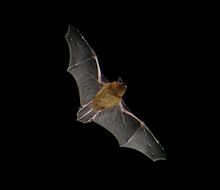Pipistrelle
| Pipistrelle | ||||||||||||
|---|---|---|---|---|---|---|---|---|---|---|---|---|

Pipistrelle bat ( Pipistrellus pipistrellus ) |
||||||||||||
| Systematics | ||||||||||||
|
||||||||||||
| Scientific name | ||||||||||||
| Pipistrellus pipistrellus | ||||||||||||
| ( Schreber , 1774) |
The pipistrelle bat ( Pipistrellus pipistrellus ) belongs to the smooth-nosed family (Vespertilionidae) and is the most common European bat species . It is one of the smallest representatives of mammals with a wingspan of up to 25 centimeters. Along with the mosquito bat, it is one of the smallest in its genus.
features
It reaches a height of 4.5 centimeters and a wingspan of up to 25 centimeters with a weight of 3.5 to 7 grams. So it weighs little more than a lump of sugar and, with folded wings, is the size of a matchbox. Their coat color is red-brown to dark brown, the underside yellow-brown to gray-brown.
Way of life
Pipistrelle bats prefer to hunt along vegetation structures. The main food is insects, especially two-winged birds such as B. Mosquitoes . Preferred hunting habitats are flown over a longer period of time and hunted. Unlike other light-shy bat species, piped bats also hunt in urban areas around street lights. The hunting areas are mostly a short distance from the nursery roosts, winter roosts can be up to approx. 50 km from the summer habitats. Usually, however, the distance between summer and winter quarters is less than 20 km. Pipistrelle bats are pronounced culture followers . Their summer quarters are usually located on buildings in crevices such as B. behind facade cladding. The females raise their young in so-called nursery roosts, which they move into from around May. The nursery roosts usually contain 50 to 100 animals, the rearing of the young takes about four weeks, then the nursery roosts dissolve. Males tend to sleep in solitary roosts. Winter roosts are probably also mostly in crevices in buildings; there are other finds of wintering pipistrelle bats in caves, crevices, tunnels and cellars. In the Carpathian Mountains there are mass winter quarters in which several 10,000 individuals winter together in caves. Before wintering, mating roosts are created in which the males try to lure females into their harem by singing flights performed in front of their courtship roost. After mating in autumn, the female stores the semen for seven to eight months before the actual fertilization takes place and the gestation period begins. The young are born in the nursery roosts from around mid-June to early July.
threat
Like all European bat species, the pipistrelle is listed in Appendix IV of the Habitats Directive and is therefore particularly strictly protected. Although it is the most common bat species in Germany, it is due to loss of roost, e.g. B. endangered by building renovations and the use of pesticides and the resulting decrease in their food base. Wind power plants pose a further threat . The pipistrelle, with a share of 21% (as of April 2013) among the bats found as victims under wind turbines, is a species severely affected by wind power. The IUCN classifies the species as not endangered due to its frequency “least concern ”. It is listed as safe in the Red List .
Systematics
The Zwergfledermaus belonging to the genus of dwarf bats ( Pipistrellus ) comprising about 35 species worldwide. In Europe, four other species that live Pipistrelle ( Pipistrellus nathusii ), the Kuhl's pipistrelle ( Pipistrellus kuhlii ), the soprano pipistrelle ( Pipistrellus pygmaeus ) and the Madeira Pipistrelle ( Pipistrellus maderensis ).
literature
- Christian Dietz, Otto von Helversen , Dietmar Nill: Handbook of the bats of Europe and Northwest Africa. Biology, characteristics, endangerment . 1st edition. Kosmos, Stuttgart 2007, ISBN 978-3-440-09693-2 , pp. 284-289.
Web links
- Pipistrellus pipistrellus onthe IUCN Red List of Threatened Species .
- The pipistrelle bat - a tiny one among the smallest
- Pipistrelle at NABU Schleswig-Holstein
Individual evidence
- ↑ Dietz et al., P. 286 ff.
- ↑ Dietz et al. P. 289
- ↑ Andreas Zahn, Anika Lustig, Mathias Hammer: Potential Effects of Wind Turbines on Bat Populations. In: ANLiegen Natur . No. 36 (1), 2014, pp. 21–35 (PDF) .
- ↑ Pipistrellus pipistrellus in the endangered Red List species the IUCN 2008. Posted by: Hutson et al, 2008. Retrieved on January 10, 2016..

